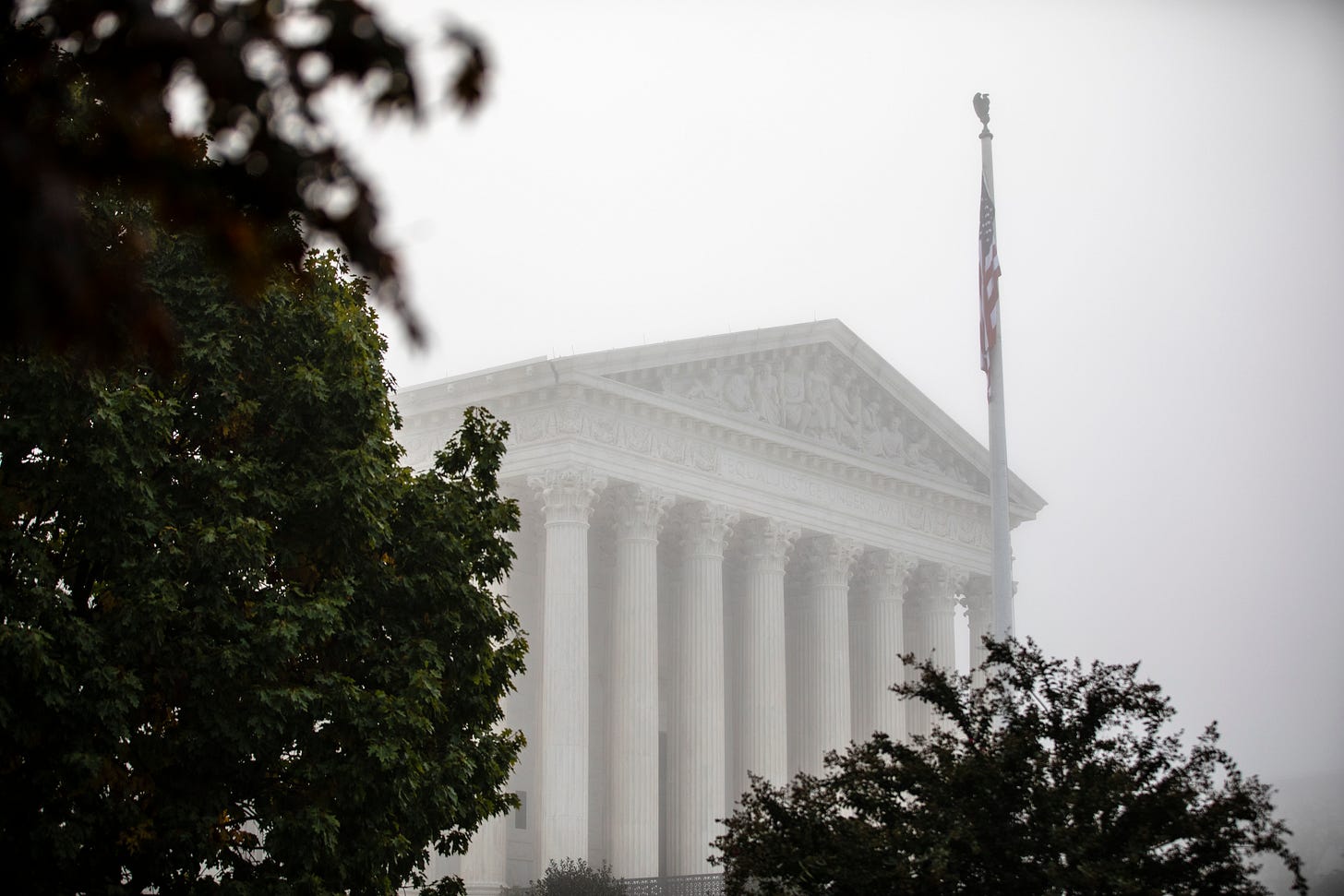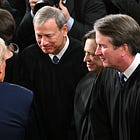How the Supreme Court taught Trump to rewrite history
"He who controls the present controls the past."
Public Notice is supported by paid subscribers. Become one ⬇️
Much has rightly been made of the camaraderie between Trump and the right-wing majority on the Supreme Court. From executive power to social issues to administrative authority, a critical mass of justices have sided with Trump time and time again to such an extent that it has started to seem like they are not separate branches of the government but rather brothers-in-arms on nearly every substantive issue.
But there’s a deeper camaraderie there too — one not only of substance, but of process. Because from reframing the events of January 6, to purging the Smithsonian of facts at odds with his worldview, Trump has proven unfortunately effective at rewriting history to give his actions a cloak of legitimacy — which is exactly what the conservative majority on the Supreme Court has been trying to do for years.
For decades now, the conservative majority on the Supreme Court has been manipulating the legal principle of stare decisis to give their own personal preferences a cloak of legitimacy. For all the non-lawyers out there (hopefully most of you) stare decisis is Latin for “to stand by things decided,” and it is the legal term for the idea that courts should respect legal precedent.
In short: stare decisis means that if a court has ruled on an issue once, subsequent courts should follow that first court’s example and rule the same way.
Stare decisis is a core concept to the way the American legal system works. It’s what gives backbone to the idea that the court system is one that works all together and not just the arbitrary product of each individual judge’s whims. It encourages the court system to remain consistent and impartial, which in turn enhances the integrity of our democracy as a whole.
In the words of the 2015 Supreme Court: stare decisis is “a foundation stone of the rule of law” because it “promotes the evenhanded, predictable, and consistent development of legal principles, fosters reliance on judicial decisions, and contributes to the actual and perceived integrity of the judicial process.”
Perhaps the most familiar example of stare decisis is its hierarchical form, in the importance of Supreme Court decisions in the US. Because of stare decisis, once the Supreme Court officially decides an issue, then all the lower courts have to decide that same issue the same way — regardless of the opinion of that particular lower court. This is why Supreme Court decisions are such a big deal in this country: once they decide an issue, it’s decided for everyone.
But stare decisis doesn’t just work hierarchically — it works over time as well. Meaning that once a court has decided the issue, that same court should later decide it the same way if it encounters the same issue. In other words: once decided, things should stay decided.
Abortion law used to be a good example of how this worked.
Beyond the breaking point
Roe first recognized a fundamental right to an abortion in 1973. In 1992, the issue came before the Supreme Court again in a case called Planned Parenthood v. Casey, where the Supreme Court again upheld the right to abortion — expressly because of stare decisis. The opinion from Justice O’Connor stated that “the reservations any of us may have in reaffirming the central holding of Roe are outweighed by the explication of individual liberty we have given combined with the force of stare decisis.”
O’Connor then went on to outline the extraordinary circumstances which would have allowed them to overrule a major precedent like Roe — circumstances that included assessing whether the previous decision was a “doctrinal anachronism discounted by society” and whether the facts have changed so drastically “as to render its central holding somehow irrelevant.” She then concluded that those criteria had not been met, and reiterated that to decide otherwise on the basis of “whatever degree of personal reluctance any of us may have” would “seriously weaken the Court’s capacity to exercise the judicial power and to function as the Supreme Court of a Nation dedicated to the rule of law.”
To those of us more accustomed to the current Supreme Court, this statement of principle is nothing short of astonishing. It clearly suggests that although many on the court may have personal qualms about the issue — and Justice O’Connor was very likely one of them — it was their job as Supreme Court justices not to let those personal feelings interfere with their job. And it offered a stark warning as to the consequences of ignoring precedent in favor of their own feelings: “to overrule under fire in the absence of the most compelling reason to reexamine a watershed decision would subvert the Court’s legitimacy beyond any serious question.”
Which brings us to today.
The current conservative majority on the Supreme Court seems to have heard O’Connor’s warning about how ignoring stare decisis would subvert the legitimacy of their Court and taken it as encouragement rather than warning. The last few years have seen a veritable onslaught of the Supreme Court overturning major precedent —precedent that concerned hot-button issues, spawned huge bodies of law on which lower courts now rely, stood for 50+ years, and had been reaffirmed multiple times by previous Courts.
And perhaps most gallingly, the Supreme Court has claimed that these overturnings were justified by the “correct” readings of history — expressly paving the way for Trump to do the same in the political arena.
To begin with the most obvious example, there is 2022’s Dobbs, which overturned not only Roe in 1973 and Casey in 1992, but Whole Woman’s Health in 2016 and June Medical Services in 2020 — meaning that it was overturning not only one decision from 50 years earlier, but a series of major Supreme Court decisions over the course of those 50 years, each of which affirmed the central holding of Roe. What’s more, the conservative majority did this by refashioning the notion of stare decisis to suit their own purposes, stating that “Stare decisis, the doctrine on which Casey’s controlling opinion was based, does not compel unending adherence to Roe’s abuse of judicial authority.”
The reason provided? “Roe was egregiously wrong from the start.” In other words: Roe doesn’t count because the Court’s current majority never liked it to begin with. This effectively converts stare decisis from a general need to respect all legal precedent into a personal principle that you only have to bother respecting precedent that you like.
Another particularly galling example is in the realm of affirmative action. The Supreme Court first affirmed the use of race-based admissions in upper education in the 1970s in a case called Bakke, and then proceeded to face variants of the issue in quite literally every decade since, each time affirming the core constitutionality of them.
It wasn’t until 2023 that the Supreme Court suddenly reversed course in SFFA, pronouncing these programs unconstitutional because “our constitutional history does not tolerate that choice” — without ever bothering to explain how the last five decades of the Supreme Court were not part of that history. As Sotomayor’s dissent pointed out: “It is a disturbing feature of today’s decision that the Court does not even attempt to make the extraordinary showing required by stare decisis. The Court simply moves the goalposts, upsetting settled expectations and throwing admissions programs nationwide into turmoil.”
These are far from the only examples. Others include last summer’s Loper Bright overturning four decades of precedent in administrative law and the upcoming term’s reconsideration of the century-old standard for executive removal of independent agency officials from Humphrey’s Executor.
The Supreme Court has also been manipulating the notion of stare decisis to rewrite American history in even more insidious ways. Most notably, they have been doing this through the use of its “shadow docket” decisions. These are decisions that happen outside of the full case-briefing process, and which are accordingly not supposed to be precedential — and yet the Supreme Court has been slinging them left and right to disrupt established precedent, overturning lower court decisions regarding the firing of former Federal Trade Commission Chair Rebecca Slaughter and mass terminations at the Department of Education, for example.
Perhaps even more worryingly, it seems like the Court’s right-wing majority now wants the lower courts to rule in anticipation of the Court overturning precedent it doesn’t like. In the shadow docket decision Trump v. Boyle (in which the Supreme Court intervened to allow Trump’s firing of two members of the NLRB) Kavanaugh provided an unusual concurrence in which he indicated lower courts should anticipate if the Supreme Court is going to overrule something and then conduct themselves accordingly.
Not only is this deeply confusing — the lower courts are not any better mind readers than the rest of us — but it also attempts to contort the idea of stare decisis beyond the breaking point. Because in this conception of the principle, it seems like courts are supposed to prioritize what the current justices think over existing precedent — which is the literal opposite of what they are supposed to do. This is an astonishing perversion of the principles underlying stare decisis and the notion that the court system should act as the reliable and impartial backbone of the US legal system.
It also provides a clear blueprint for the way Trump loves to rewrite history.
Choose your own history
Much like the Supreme Court, Trump does not only claim that he is right because he is so brilliant (though he certainly likes to claim that too) — he claims he is right because his version of American history is correct. The Supreme Court showed him how to cherry-pick helpful facts (or invent them) from predecessors, ignore everything else, and then claim that these hand-selected facts justify whatever he wants.
Even their language is astonishingly similar. For instance, Trump’s executive order purporting to tell the Smithsonian how to do its job claims that all versions of history that he doesn’t like are “corrosive ideology” — while in Loper Bright, the Supreme Court overturned four decades of administrative law by calling it “crumbling precedent.”
And when the Trump administration says we must scrub mentions of slavery from National Parks because it does not fit with America’s “extraordinary heritage, consistent progress toward becoming a more perfect Union, and unmatched record of advancing liberty, prosperity, and human flourishing,” it is hard not to also think of the Supreme Court’s statement that abortion is not “deeply rooted in this Nation’s history and tradition” — a phrase first used by the Rehnquist court in 1997 in Washington v Glucksberg, and which has now grown into the conservative majority’s tool to dismiss any rights they don’t like.
To use another legal term, it’s tempting to think of Trump as sui generis — a unique phenomenon that came out of nowhere due simply to the strength of his personality. But the truth is that while his force of personality might be unique, the tactics he’s using to lend legitimacy have been carefully cultivated for a long time.
So if you’re wondering where Trump learned the trick of recasting American history as uniquely belonging to him, look no further than the current Supreme Court’s manipulation of the core legal principle of stare decisis. Because more than any specific policy goal, this is where Trump and the Supreme Court are now aligned: they both want to be the people who decide what makes up “real” American history.
That’s it for today
We’ll be back with a special Saturday edition tomorrow. If you appreciate today’s PN, please do your part to keep us almost entirely free by supporting our work with a paid subscription.
Thanks for reading, and for your support.







This is a vital and well-argued piece, and I appreciate the clarity with which you connect legal manipulation to historical revisionism.
From a behavioral lens, what you’ve described is institutional mimicry: when power centers begin to mirror each other’s tactics not just in outcome, but in process. The rhetorical reframing and the Court’s jurisprudential contortions both serve the same function—-to make selective memory look like constitutional principle.
I’ve written before about how stare decisis, when hollowed out, becomes less a safeguard and more a stage prop. The conservative majority isn’t just discarding precedent, they’re rebranding it as ideological decay. That’s not legal reasoning. That’s narrative control.
And when the executive and judicial branches converge on the same strategy, to define “real” history by what flatters their worldview, we’re no longer debating policy.
We’re watching the architecture of pluralism being quietly dismantled.
Thank you for naming it.
— Johan
Professor of Behavioral Economics and Applied Cognitive Theory
Former Foreign Service Officer
In return, a grateful Donald Trump has taught the Court … to whine like an aggrieved white bully.